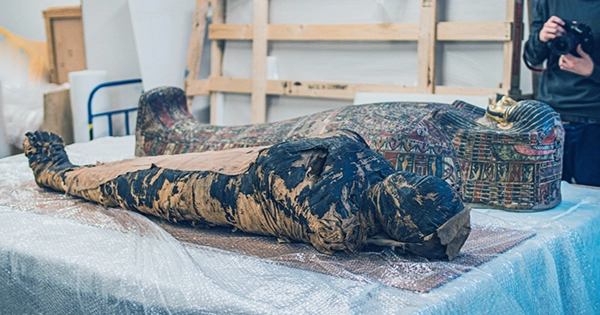Researchers have discovered a fetus that has been preserved like a “pickle” in the womb of a 2,000-year-old ancient Egyptian corpse. Last year, a team from the Warsaw Mummy Project reported the astonishing finding of the first known pregnant Egyptian mummy. The researchers were intrigued by the so-called “Mysterious Lady,” so they employed CT scans to obtain a closer peek inside this one-of-a-kind mummy.
“There is no other example of a pregnant ancient mummy that the scientific community is aware of,” Dr. Wojciech Ejsmond of the Polish Academy of Sciences, the study’s lead author, told IFLScience. “There is no other case of a pregnant ancient mummy that the scientific community is aware of.” They discovered more proof that the body’s pelvic cavity housed a fetus thanks to CT images. However, the question of how the fetus remained intact after 2,000 years remained unanswered. The team revealed that the fetus was preserved in a similar way to “bog bodies” in a recent report published in the Journal of Archaeological Science.
Bog bodies are human cadavers that have mummified organically in a peat bog’s very acidic and low oxygen environment. A fetus left inside a mummy preserved using typical ancient Egyptian embalming procedures appears to go through a similar process. The pH of a person’s blood normally drops after death, becoming progressively more acidic as ammonia and formic acid concentrations rise over time.
Furthermore, the fetus is hermetically sealed inside the womb, much like a peat bogs hypoxic (low oxygen) conditions. “The fetus stayed unharmed in the uterus and proceeded to ‘pickle,’ as it were.” In a blog post, the Warsaw Mummy Project remarked, “It is not the most attractive comparison, but it conveys the notion.”
The outside of the fetus is remarkably well preserved, similar to that of a bog cadaver, but their bones have nearly completely vanished. This is because in a very acidic environment, the bone undergoes a process called demineralization. The fetus had previously gone undetected because it lacked any sign of bones, which is a vital trait that typically noticed X-rays and other examinations. “When looking at X-rays and CT scans, researchers are usually hunting for bones,” Dr. Ejsmond told IFLScience.
“For our investigation, we used very high-quality equipment that allowed us to observe a lot of details,” he continued. “Our research revealed that fetuses’ bones may be very poorly preserved due to unique taphonomic processes that occurred during embalming, and thus may not be seen in CTs and X-rays,” says the researcher. This opens up many intriguing possibilities. Because standard approaches would have missed the fetus, it is likely that additional ancient mummies in other museum collections perished with pregnant children still attached.
“We’ve been contacted by certain scholars who believe the mummies they’ve discovered or are researching may be pregnant,” Dr. Ejsmond explained. “We’ll look into it and look into more mummies.” There are undoubtedly more comparable examples, but no one has paid attention to them thus far.” In the meantime, this is the only known pregnant mummy, which raises more concerns than it answers: why was the mummy’s fetus preserved but other parts removed, was this common procedure, and what does this suggest for Egyptian conceptions of the afterlife in terms of children?
















